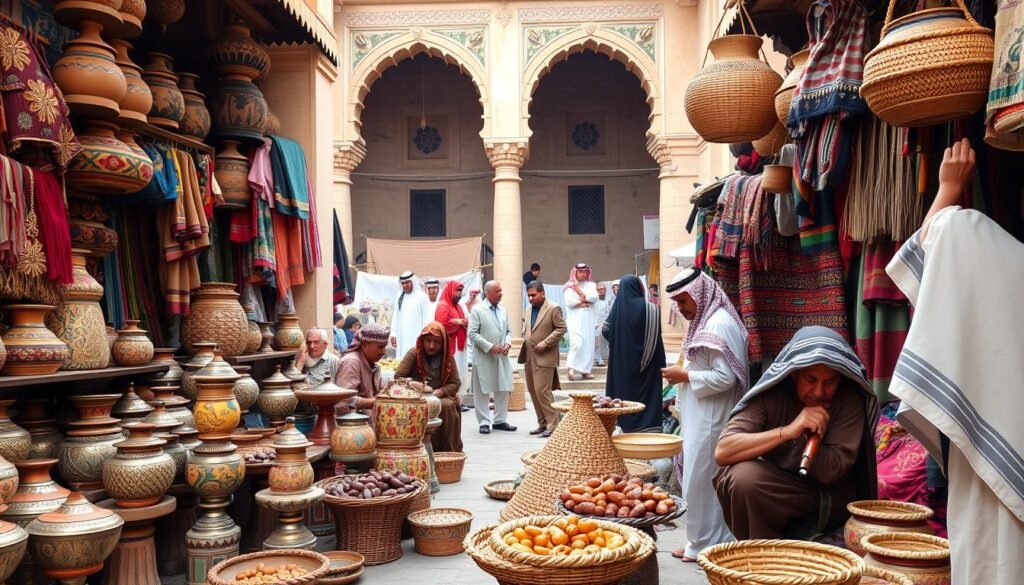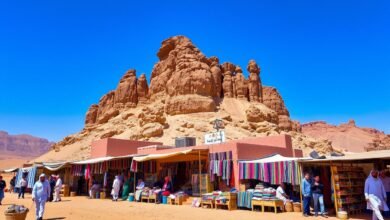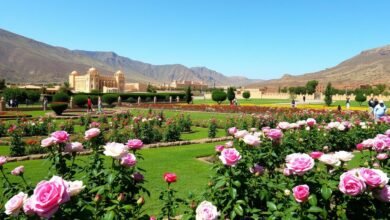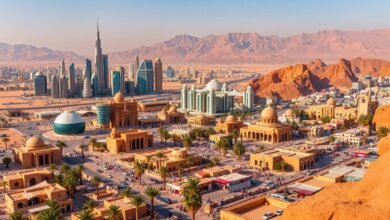Exploring the Heart of Saudi Culture: Best Destinations

Imagine stepping into a world where old traditions meet modern life. Here, the sands of time show a rich cultural heritage. Welcome to Saudi Arabia, a place that calls to those who love to explore and discover.
But what’s at the heart of this mysterious kingdom? How can you really feel its true spirit? Let’s find out by visiting the best places that show the real Saudi culture.
In Saudi Arabia, cities buzz with life, mixing old and new. And ancient sites tell stories of the past. This country invites you to join a unique cultural journey.
As we explore this fascinating land, a big question arises: What secrets and surprises await the curious traveler who seeks to uncover the essence of Saudi Arabia’s cultural heart?
Understanding Saudi Arabia’s Cultural Landscape
Saudi Arabia’s culture is a mix of old traditions and new changes. It is deeply rooted in the Arabian Peninsula’s history. Islam has greatly influenced Saudi society.
Ancient Origins and Modern Transformation
The Bedouin tribes of Saudi Arabia have a long history. Their nomadic lifestyle and connection to the land have lasted for centuries. The country, being the birthplace of Islam, has evolved. It now combines its old customs with modern life.
The Five Regions of Saudi Cultural Heritage
- Central Region: The heart of Saudi Arabia, known for its traditional mud-brick buildings and historic oases.
- Western Region: Home to Mecca and Medina, the spiritual heart of the Muslim world.
- Eastern Region: Known for its lively coastal cities, pearling industry, and maritime history.
- Northern Region: Famous for its ancient rock formations, lush oases, and past civilizations.
- Southern Region: Known for its rugged mountains, diverse Bedouin communities, and unique traditions.
Impact of Islam on Saudi Society
Islam deeply influences Saudi Arabian culture. It shapes daily life, social customs, and art. The Five Pillars of Islam guide the nation’s values and traditions.
| Cultural Heritage Sites | Significance |
|---|---|
| Al-Masjid al-Haram (The Grand Mosque) | The holiest site in Islam, housing the Kaaba, the direction of prayer for all Muslims. |
| Al-Masjid an-Nabawi (The Prophet’s Mosque) | The second-holiest site in Islam, the burial place of Prophet Muhammad. |
| Hegra (Mada’in Salih) | An ancient Nabataean city and UNESCO World Heritage Site, featuring well-preserved rock-cut tombs. |
Riyadh: A Blend of Tradition and Modernity
Riyadh, the capital of Saudi Arabia, is a mix of old and new. It’s the heart of the kingdom’s business and government. The city has changed a lot, keeping its history alive while adding new things.
The Al-Masmak Fortress is a key spot in Riyadh. It’s from the late 19th century. Its mud-brick walls and towers show the city’s role in history.
The National Museum of Saudi Arabia is full of history. It has many artifacts and exhibits. You can learn about Saudi’s ancient times and its modern successes.
Riyadh’s modern side is impressive. It has tall buildings and new designs. The Kingdom Centre has a skywalk and deck. From there, you can see the whole city.
Al-Dira’iyah is a place to see Saudi culture. It was the first Saudi capital. Now, it’s full of traditional shops, art, and events.
Riyadh shows the best of Saudi culture. By visiting, you can understand the city’s mix of old and new. It’s a great way to see the riyadh attractions and experience Saudi culture.
Jeddah’s Historic Al-Balad District: A UNESCO World Heritage Site
In the heart of Jeddah, the Al-Balad district is a treasure trove of Saudi Arabia’s history. It’s a UNESCO site that shows the traditional Saudi way of life. You can see its stunning coral-stone buildings, lively markets, and old trading paths.
Traditional Coral Houses and Architecture
The Al-Balad district is famous for its coral-stone houses. These buildings, some over a century old, are a marvel of local craftsmanship. They were built using coral, which was abundant, to withstand the climate.
Historical Markets and Trading Routes
Al-Balad was a major trading center in the past. Its markets were always buzzing with activity. Today, you can still find local goods like textiles, pottery, and jewelry in these markets.
Cultural Preservation Efforts
- Ongoing restoration and conservation initiatives to preserve the architectural heritage of Al-Balad
- Establishment of cultural centers and museums to showcase the district’s historical significance
- Efforts to maintain the traditional craft and trade practices that have defined the area for generations
Thanks to these efforts, Al-Balad remains a place of wonder. It shows the enduring charm and commitment to preserving Saudi Arabia’s cultural heritage.
Al-Ula: Gateway to Ancient Nabataean Civilization
Al-Ula is in northwestern Saudi Arabia, showing the country’s rich history. It’s known as the gateway to the Nabataean civilization. This civilization made a big impact on the area’s past.
Exploring Al-Ula feels like stepping back in time. I see amazing rock-cut tombs and petroglyphs. These were carved into cliffs, showing the Nabataeans’ skill in engineering and art.
Excavations in Al-Ula are revealing more about the Nabataeans. We learn about their life, trade, and beliefs. Places like Hegra, Jabal Ithlib, and Dadan ruins are key to understanding their culture.
Walking through Al-Ula’s streets, I feel the history all around. It reminds us of the Nabataeans’ lasting influence. This site is a big part of Saudi Arabia’s tourism.
| Key Attractions in Al-Ula | Highlights |
|---|---|
| Hegra (Madain Saleh) | A UNESCO World Heritage Site featuring well-preserved Nabataean rock-cut tombs and inscriptions |
| Jabal Ithlib | An ancient mountain site with intricate petroglyphs and rock art |
| Dadan Ruins | The former capital of the Dadan and Lihyan kingdoms, known for its impressive archaeological remains |
| Old Town of Al-Ula | A well-preserved historic district showcasing traditional Nabataean architecture and lifestyle |
Leaving Al-Ula, I have a deep respect for its history and the Nabataeans. This place is a key to understanding Saudi Arabia’s rich past and traditions.
Exploring the Heart of Saudi Culture: Best Destinations for an Authentic Experience
Dive into the rich world of Saudi traditions and customs. Explore the kingdom’s most exciting cultural spots. This part shows you the heart of Saudi Arabia through its traditions.
Local Customs and Etiquette
Exploring Saudi culture is a rewarding journey. Learn about local customs and etiquette to respect and connect with the culture. Understand greetings, dress codes, and social norms to blend in and enjoy the local lifestyle.
Traditional Festivals and Celebrations
See the colorful festivals and celebrations of Saudi Arabia. Experience Eid al-Fitr and the Janadriyah cultural festival. Enjoy traditional dances, try authentic food, and meet the community for a memorable time.
Bedouin Heritage Sites
Discover the Bedouin people’s legacy in Saudi Arabia. Visit their ancient sites and oases. Meet the Bedouin, learn about their crafts, and see their ancient desert culture.

Traditional Saudi Cuisine and Dining Customs
Diving into Saudi Arabia’s rich culture means exploring its traditional food and dining ways. Saudi hospitality is all about welcoming guests with food, showing the country’s deep traditions. Food is key in this social bond.
Saudi food varies by region, showing off the country’s different lands. Najd’s stews and Eastern Province’s rice dishes are just a few examples. These dishes highlight Saudi chefs’ creativity and love for cooking.
Dining in Saudi Arabia is more than just eating. It’s a special time for people to come together. Meals are shared, bringing families and friends closer. They enjoy the tastes of their heritage together.
Exploring Regional Specialties
- Mabshoor: A slow-cooked lamb or beef dish from the Najd region, often seasoned with fragrant spices like cardamom and saffron.
- Kabsa: A fragrant rice dish from the Eastern Province, typically featuring chicken or lamb, and a blend of aromatic spices.
- Saleeg: A traditional rice dish from the Asir region, characterized by its distinctive yellow color and delicate flavors.
The Art of Saudi Dining
- Communal Dining: Sharing meals from a central platter is a common practice, encouraging social interaction and a sense of community.
- Hospitality and Etiquette: Guests are often greeted with traditional coffee ceremonies and expected to follow specific etiquette, such as using the right hand for eating.
- Timing and Pacing: Meals in Saudi Arabia are often leisurely affairs, with time taken to savor each course and engage in conversation.
Discovering Saudi Arabia’s culinary heritage is a deep dive into its culture. It shows the true spirit of Saudi hospitality. From the diverse flavors to the cherished dining customs, it’s a journey into the kingdom’s heart.
The Art of Arabian Hospitality
Exploring Saudi culture means diving into Arabian hospitality. This tradition has been around for centuries. It shapes how locals treat guests and visitors.
Coffee Ceremonies and Social Traditions
The heart of Saudi hospitality is the coffee ceremony, or gahwa. It’s not just about coffee; it’s a sign of respect, generosity, and community. Guests are greeted with the scent of gahwa, often with dates or sweets.
The gahwa ceremony is a detailed performance. It shows the host’s care and value for the guest. From the copper pots to the pouring, it’s an art that shows arabian hospitality.
Guest Etiquette in Saudi Homes
Visiting a Saudi home is a special honor. It comes with cultural rules to follow. Guests must remove their shoes and women may need to cover their heads or wear modest clothes.
When talking in a Saudi home, be careful. Avoid sensitive topics and be mindful of your body language and tone. This way, you can fully experience exploring the heart of saudi culture: best destinations for an authentic experience.

Arabian hospitality is more than coffee and traditions. It’s a big part of Saudi culture, influencing how locals welcome guests. By understanding and respecting these customs, visitors can truly explore the heart of Saudi culture. They’ll appreciate the warmth and generosity of this amazing country.
Sacred Sites and Religious Heritage
Saudi Arabia’s rich culture is deeply rooted in its religious history. It is home to the two holiest sites in Islam. This gives visitors a chance to dive into the spiritual and historical value of these places.
The Two Holy Mosques: Mecca and Medina
The heart of Saudi Arabia’s religious scene is the Masjid al-Haram in Mecca and the Masjid an-Nabawi in Medina. The Masjid al-Haram houses the Kaaba, and the Masjid an-Nabawi is where Prophet Muhammad is buried. Millions of Muslims visit each year to perform the Hajj and Umrah rituals.
Historic Religious Centers
Saudi Arabia also has many historic religious sites. These include ancient mosques, shrines, Sufi lodges, and Quranic schools. They show the variety and growth of Islamic practices in the kingdom.
| Cultural Heritage Site | Location | Significance |
|---|---|---|
| Al-Masjid al-Nabawi | Medina | The second holiest site in Islam, the burial place of Prophet Muhammad |
| Al-Masjid al-Haram | Mecca | The holiest site in Islam, housing the Kaaba, the direction of prayer for Muslims worldwide |
| Masmak Fortress | Riyadh | An important historical site that played a key role in the unification of Saudi Arabia |
| Jebel Akhdar | Asir Mountains | Home to numerous Sufi shrines and lodges, reflecting the region’s rich spiritual heritage |
Visitors should respect local customs and etiquette when visiting these sites. This includes wearing appropriate clothing and behaving respectfully. Doing so allows for a deeper understanding and appreciation of Saudi Arabia’s religious heritage.
Modern Cultural Attractions and Museums
Exploring Saudi culture reveals a vibrant, changing scene. The National Museum of Saudi Arabia and the lively art scenes are key. These spots show the nation’s artistic and cultural growth.
The National Museum gives a deep look into Saudi history and traditions. Art galleries and cultural events show the creative spirit of Saudi Arabia’s future.
National Museum of Saudi Arabia
The National Museum of Saudi Arabia in Riyadh is a top spot for cultural exploration. It has a vast collection of artifacts and interactive exhibits. These show Saudi society’s journey from ancient times to now.
Walking through the museum, I’m amazed by its design and the way it brings history to life.
Contemporary Art Scenes
Saudi Arabia’s culture is also alive with modern art. Cities like Riyadh and Jeddah are hubs for creativity. Here, you can see the talents of Saudi artists and the nation’s evolving culture.
From galleries to street art, the art scenes in Saudi Arabia are vibrant. They show the country’s growth in the arts.
Cultural Events Calendar
Exploring Saudi Arabia’s cultural events has been enriching. The country hosts many festivals and exhibitions all year. These events celebrate the nation’s diversity and showcase its artistic spirit.
As I plan my trip, I’m looking forward to the cultural calendar. I’m excited to see the authentic experiences Saudi Arabia offers.
FAQ
What are the best destinations to explore the heart of Saudi culture?
Visit Riyadh, Jeddah’s historic Al-Balad district, and Al-Ula. These places show Saudi Arabia’s rich culture. You’ll see ancient history and modern life.
How can I experience the traditional Saudi lifestyle?
Visit Bedouin sites and join local festivals. Learn about customs and hospitality. Exploring historic areas and markets gives great insights.
What are some of the must-see cultural heritage sites in Saudi Arabia?
See Jeddah’s Al-Balad district and Al-Ula’s Nabataean ruins. Also, visit important Islamic sites. These places show Saudi Arabia’s history and culture.
How can I immerse myself in the local culture and traditions during my visit?
Join festivals, experience Bedouin hospitality, and talk to locals. Learn about etiquette and coffee ceremonies. This will make your visit more meaningful.
What are some of the unique aspects of Saudi Arabian cuisine and dining customs?
Saudi food reflects its history and diverse influences. Meals are important for hospitality. Try local dishes and understand food’s role in culture.
What should I know about Arabian hospitality when visiting Saudi Arabia?
Arabian hospitality is key in Saudi culture. Know about coffee ceremonies and respect for guests. This will help you connect with locals and have a better experience.
What are some of the modern cultural attractions and museums I should visit in Saudi Arabia?
Saudi Arabia has a modern cultural scene. Visit the National Museum of Saudi Arabia in Riyadh. Also, check out Jeddah’s art scene and cultural events.




